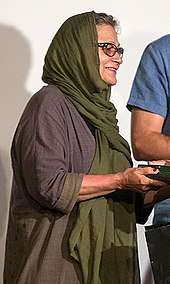Hengameh Golestan
Hengameh Golestan (born Hengameh Jalali,[1] 1952) is an Iranian photographer. She is considered a pioneer among Iranian women photographers.[2]

In March 1979, when in the aftermath of the Iranian Revolution women in Iran began protesting the new government's rule ordering them to wear hijabs, she photographed the gatherings in the capital, in the process becoming one of few documentary photographers active in the country.
Life and work
Golestan began working as a photographer at the age of 18; for a while she attended photography school in England, but otherwise she learned the craft from working as an assistant to her husband, photojournalist Kaveh Golestan;[3] the couple had married in 1975, and later had a son, Mehrak.[1]
She began her career in 1972, when there were only a handful of women photographers in the country.[4] At the start of her career her preferred subject was everyday life in Tehran. However, in March 1979, when in the aftermath of the Iranian Revolution women in Iran began protesting the new government's rule ordering them to wear hijabs, she photographed the gatherings in the capital, in the process becoming one of few documentary photographers active in the country.[3] These photographs became the basis for the "Witness 1979" series,[5] the majority of which was not exhibited until 2015.[3]
Later in her career, Golestan asked to travel to the front lines to photograph the Iran–Iraq War, a request which was denied due to her gender.[4]
She moved to London with her husband and son in 1984.[3]
Stylistically, Golestan has cited Mary Ellen Mark and Diane Arbus as influences on her work.[4]
Collections
Golestan's work is held in the following public collection:
- Arthur M. Sackler Gallery, Smithsonian Institution: seven photographs from the "Witness 1979" series[6]
References
- Roth, Andrew (3 April 2003). "Obituary: Kaveh Golestan". The Guardian. Archived from the original on 9 July 2018. Retrieved 2 November 2018.
- Yildiz, Duygu. "Hengameh Golestan: photographing women in Tehran, 1979". Archived from the original on 17 December 2018. Retrieved 2 November 2018.
- Davies, Lucy (10 September 2015). "Witness to revolution: the women of Iran 1979". Telegraph. Archived from the original on 13 December 2018. Retrieved 2 November 2018.
- Cain, Sian (3 September 2015). "Hengameh Golestan's best photograph: Iranian women rebel against the 1979 hijab law". The Guardian. Archived from the original on 7 January 2019. Retrieved 2 November 2018.
- Hengameh, Golestan; Azadeh, Fatehrad (4 September 2015). "Hengameh Golestan : Witness 1979". eprints.kingston.ac.uk. Archived from the original on 17 December 2018. Retrieved 2 November 2018.
- "Explore the Sackler Contemporary Collection – Freer". www.freersackler.si.edu. Archived from the original on 2018-12-17. Retrieved 2018-11-02.